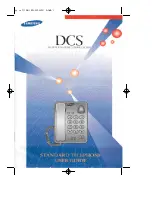
Smooth Operator Configuration Note (77200)
Panasonic DBS
C o n f i d e n t i a l
P a g e
1 4
The above information is provided by Octel Communications Corporation as a guide.
See disclaimer on page 1
O c t e l C o m m u n i c a t i o n s
7.8
VERIFYING CPC VERSION
The CPC version number can be displayed by entering:
ON/OFF CONF 7777
7.9
DID/DNIS TO A SMOOTH OPERATOR MAILBOX
This feature can be used with Smooth Operator systems. If the feature is
used with Smooth Operator systems, the Smooth Operator can be
connected through analog extension ports or OPX ports.
DID/DNIS digit transmission. The DID/DNIS digits are only sent to ports
that are assigned as voice mail.
Smooth Operator ports and hunt groups. The DID/DNIS digits can be sent
to a specific Smooth Operator port or a Smooth Operator hunt group.
Second hunt group. If the DID/DNIS call rings into a hunt group that in
turn transfers the call to a second hunt group, the DID/DNIS calls are not
transmitted to the second hunt group.
Call forward ID. When DID/DNIS calls are forwarded to Smooth Operator,
the Call Forward ID Code is transmitted to the Smooth Operator. The
DID/DNIS digits are not.
Restriction For CPC-B Version 3.1. This address is also present in CPC-B
Version 3.1; however, it only controls Multiple DID (DNIS cannot be used
with this version).
DID/DNIS Digit Length Requirement. The DBS only supports 4-digit
DID/ DNIS numbers.
Central Office Requirement. When the CO sends a DID/DNIS call to the
DBS, it first receives a wink from the DBS before sending the digits. Once
the wink is received, the CO should wait at least 200 ms before sending the
digits.
Simultaneous Ringing. If Multiple DID/DNIS is enabled, all extensions
assigned the same DID/DNIS number will ring for the incoming
DID/DNIS call. If you later disable Multiple DID/DNIS, only the
extension at the lowest-numbered port will ring for the DID/DNIS call.
Call Forwarding Interaction. If Multiple DID/DNIS is enabled, and the
DID/DNIS extensions are programmed to call-forward to different
extensions, the simultaneous ringing will also apply to the call-forward
destination extensions. In other words, all call-forward paths will be
followed simultaneously for the same DID/DNIS call, until someone picks
it up. If you later disable Multiple DID/DNIS, only the call-forwarding
path assigned to the extension at the lowest-numbered port will be
followed.
CPC-B Version 6.0 and higher



































